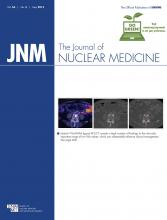Research ArticleClinical Investigations
Cerebellum Can Serve As a Pseudo-Reference Region in Alzheimer Disease to Detect Neuroinflammation Measured with PET Radioligand Binding to Translocator Protein
Chul Hyoung Lyoo, Masamichi Ikawa, Jeih-San Liow, Sami S. Zoghbi, Cheryl L. Morse, Victor W. Pike, Masahiro Fujita, Robert B. Innis and William Charles Kreisl
Journal of Nuclear Medicine May 2015, 56 (5) 701-706; DOI: https://doi.org/10.2967/jnumed.114.146027
Chul Hyoung Lyoo
1Department of Neurology, Gangnam Severance Hospital, Yonsei University College of Medicine, Seoul, South Korea
2Molecular Imaging Branch, National Institute of Mental Health, National Institutes of Health, Bethesda, Maryland; and
Masamichi Ikawa
2Molecular Imaging Branch, National Institute of Mental Health, National Institutes of Health, Bethesda, Maryland; and
Jeih-San Liow
2Molecular Imaging Branch, National Institute of Mental Health, National Institutes of Health, Bethesda, Maryland; and
Sami S. Zoghbi
2Molecular Imaging Branch, National Institute of Mental Health, National Institutes of Health, Bethesda, Maryland; and
Cheryl L. Morse
2Molecular Imaging Branch, National Institute of Mental Health, National Institutes of Health, Bethesda, Maryland; and
Victor W. Pike
2Molecular Imaging Branch, National Institute of Mental Health, National Institutes of Health, Bethesda, Maryland; and
Masahiro Fujita
2Molecular Imaging Branch, National Institute of Mental Health, National Institutes of Health, Bethesda, Maryland; and
Robert B. Innis
2Molecular Imaging Branch, National Institute of Mental Health, National Institutes of Health, Bethesda, Maryland; and
William Charles Kreisl
2Molecular Imaging Branch, National Institute of Mental Health, National Institutes of Health, Bethesda, Maryland; and
3Taub Institute for Research on Alzheimer’s Disease and the Aging Brain, Columbia University Medical Center, New York, New York

Data supplements
Supplemental Data
Files in this Data Supplement:
In this issue
Journal of Nuclear Medicine
Vol. 56, Issue 5
May 1, 2015
Cerebellum Can Serve As a Pseudo-Reference Region in Alzheimer Disease to Detect Neuroinflammation Measured with PET Radioligand Binding to Translocator Protein
Chul Hyoung Lyoo, Masamichi Ikawa, Jeih-San Liow, Sami S. Zoghbi, Cheryl L. Morse, Victor W. Pike, Masahiro Fujita, Robert B. Innis, William Charles Kreisl
Journal of Nuclear Medicine May 2015, 56 (5) 701-706; DOI: 10.2967/jnumed.114.146027
Cerebellum Can Serve As a Pseudo-Reference Region in Alzheimer Disease to Detect Neuroinflammation Measured with PET Radioligand Binding to Translocator Protein
Chul Hyoung Lyoo, Masamichi Ikawa, Jeih-San Liow, Sami S. Zoghbi, Cheryl L. Morse, Victor W. Pike, Masahiro Fujita, Robert B. Innis, William Charles Kreisl
Journal of Nuclear Medicine May 2015, 56 (5) 701-706; DOI: 10.2967/jnumed.114.146027
Jump to section
Related Articles
Cited By...
- [11C]PS13 Demonstrates Pharmacologically Selective and Substantial Binding to Cyclooxygenase-1 in the Human Brain
- Remote Neuroinflammation in Newly Diagnosed Glioblastoma Correlates with Unfavorable Clinical Outcome
- [18F]DPA-714 PET Imaging in the Presurgical Evaluation of Patients With Drug-Resistant Focal Epilepsy
- Individual regional associations between A{beta}-, tau- and neurodegeneration (ATN) with microglial activation in patients with primary and secondary tauopathies
- [18F]ROStrace detects oxidative stress in vivo and predicts progression of Alzheimers disease pathology in APP/PS1 mice
- Mitochondrial control of microglial phagocytosis in Alzheimers disease
- Microglia Activation in Basal Ganglia Is a Late Event in Huntington Disease Pathophysiology
- Association of Early {beta}-Amyloid Accumulation and Neuroinflammation Measured With [11C]PBR28 in Elderly Individuals Without Dementia
- Olfactory impairment is related to tau pathology and neuroinflammation in Alzheimers disease
- Moving Toward Multicenter Therapeutic Trials in Amyotrophic Lateral Sclerosis: Feasibility of Data Pooling Using Different Translocator Protein PET Radioligands
- Regional protein expression in human Alzheimers brain correlates with disease severity
- Automatic Extraction of a Reference Region for the Noninvasive Quantification of Translocator Protein in Brain Using 11C-PBR28
- We need to talk about reliability: Making better use of test-retest studies for study design and interpretation
- Head-to-Head Comparison of 11C-PBR28 and 18F-GE180 for Quantification of the Translocator Protein in the Human Brain
- Neuroinflammation Appears Early on PET Imaging and Then Plateaus in a Mouse Model of Alzheimer Disease
- Pseudoreference Regions for Glial Imaging with 11C-PBR28: Investigation in 2 Clinical Cohorts
- The 5-HT1A Receptor PET Radioligand 11C-CUMI-101 Has Significant Binding to {alpha}1-Adrenoceptors in Human Cerebellum, Limiting Its Use as a Reference Region
- Parametric Binding Images of the TSPO Ligand 18F-DPA-714
- Glial Activation and Glucose Metabolism in a Transgenic Amyloid Mouse Model: A Triple-Tracer PET Study
- Imaging Microglial Activation with TSPO PET: Lighting Up Neurologic Diseases?






